Teaching Plan for Subcutaneous Injection Technique
VerifiedAdded on 2023/06/10
|17
|2077
|128
AI Summary
This teaching plan outlines the objectives, rationale, learning outcomes, target audience, learning theory, teaching strategy, materials needed, and evaluation methods for teaching subcutaneous injection technique. The target audience is a group of 20 patients aged 35-40 years diagnosed with Diabetes 2. The learning theory applied is Constructivism, Behaviorism, and Cognitive Theories. The teaching strategy is clinical training, and the materials needed include single dose vial vaccine, needle and syringes, alcohol swabs, and trash cans. The evaluation method is asking the students to demonstrate what they have learned.
Contribute Materials
Your contribution can guide someone’s learning journey. Share your
documents today.
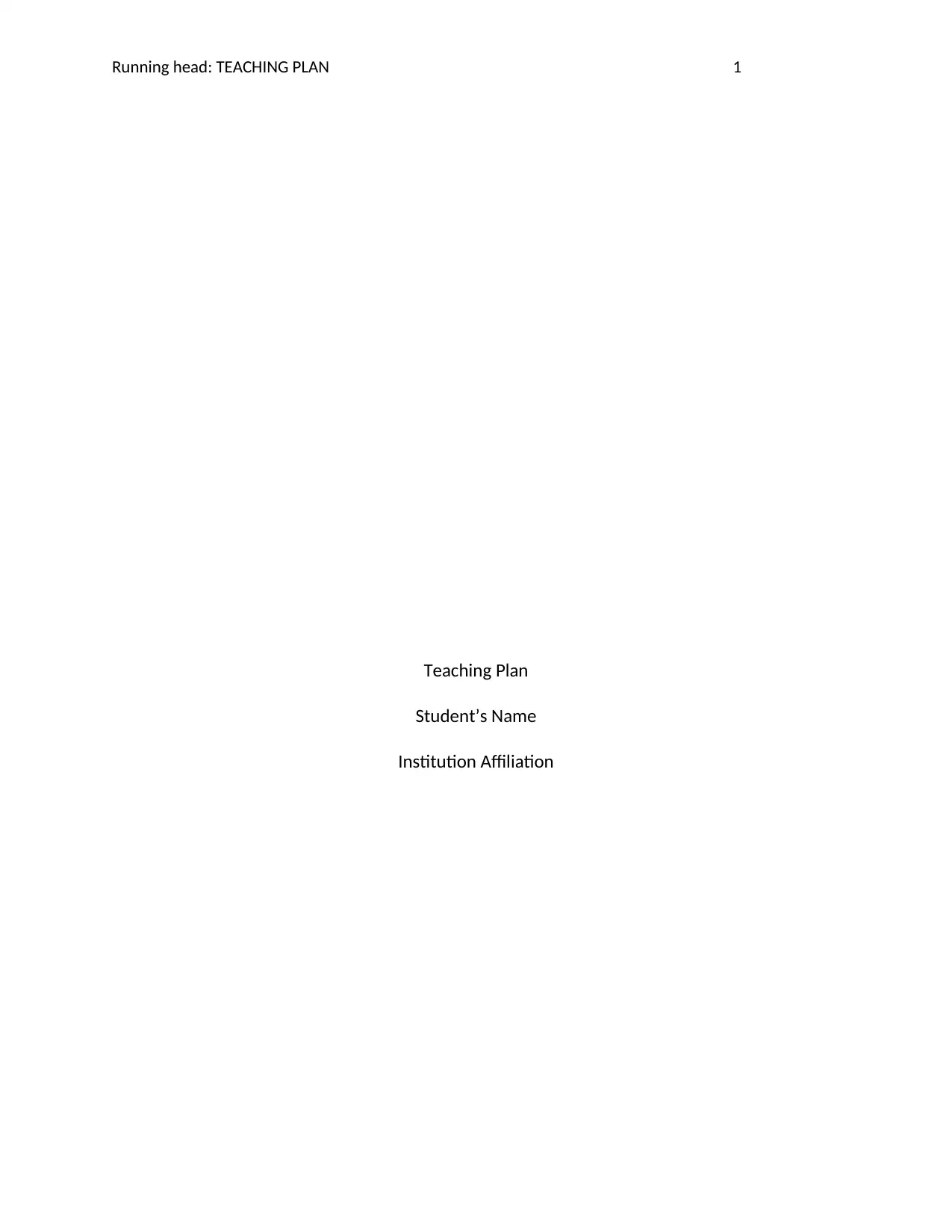
Running head: TEACHING PLAN 1
Teaching Plan
Student’s Name
Institution Affiliation
Teaching Plan
Student’s Name
Institution Affiliation
Secure Best Marks with AI Grader
Need help grading? Try our AI Grader for instant feedback on your assignments.
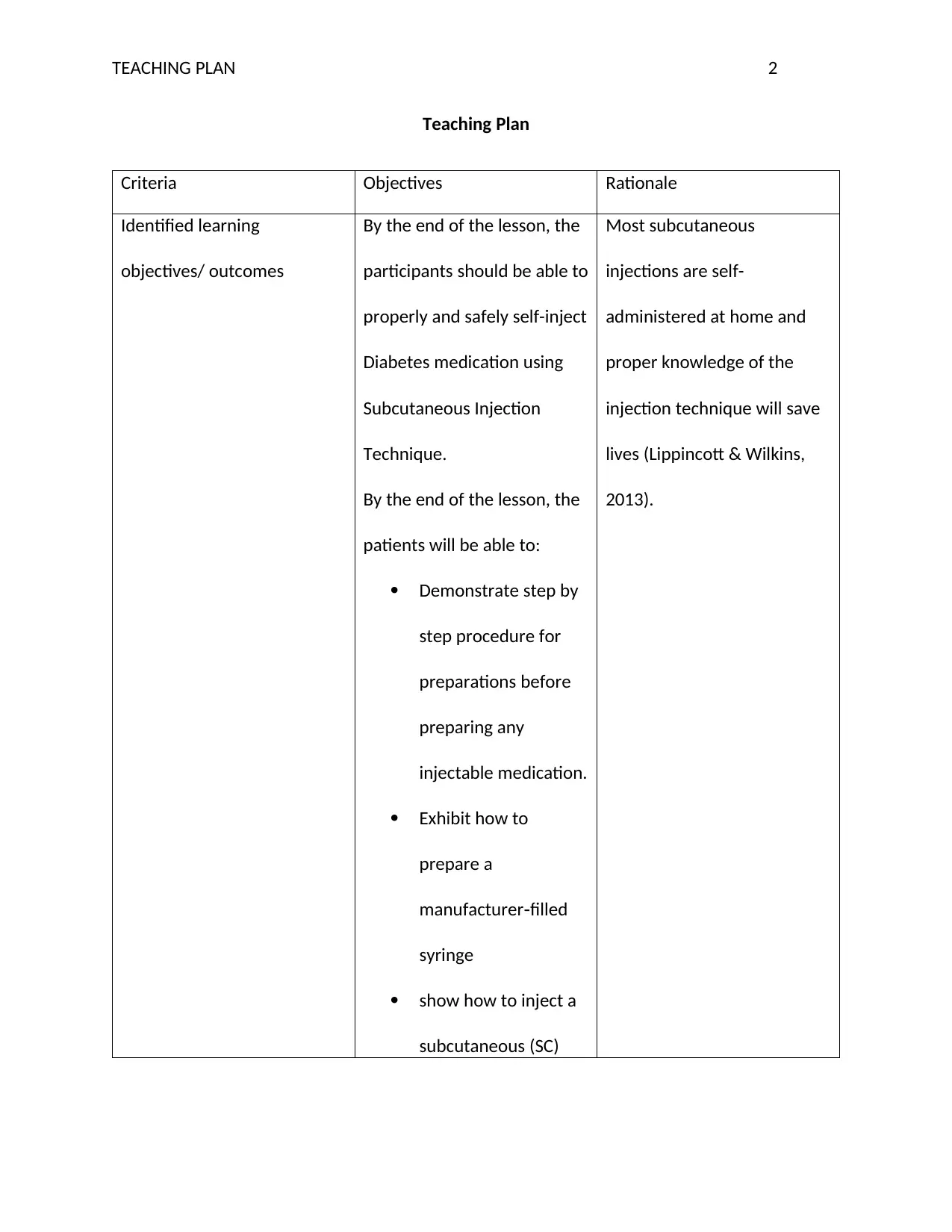
TEACHING PLAN 2
Teaching Plan
Criteria Objectives Rationale
Identified learning
objectives/ outcomes
By the end of the lesson, the
participants should be able to
properly and safely self-inject
Diabetes medication using
Subcutaneous Injection
Technique.
By the end of the lesson, the
patients will be able to:
Demonstrate step by
step procedure for
preparations before
preparing any
injectable medication.
Exhibit how to
prepare a
manufacturer filled‐
syringe
show how to inject a
subcutaneous (SC)
Most subcutaneous
injections are self-
administered at home and
proper knowledge of the
injection technique will save
lives (Lippincott & Wilkins,
2013).
Teaching Plan
Criteria Objectives Rationale
Identified learning
objectives/ outcomes
By the end of the lesson, the
participants should be able to
properly and safely self-inject
Diabetes medication using
Subcutaneous Injection
Technique.
By the end of the lesson, the
patients will be able to:
Demonstrate step by
step procedure for
preparations before
preparing any
injectable medication.
Exhibit how to
prepare a
manufacturer filled‐
syringe
show how to inject a
subcutaneous (SC)
Most subcutaneous
injections are self-
administered at home and
proper knowledge of the
injection technique will save
lives (Lippincott & Wilkins,
2013).
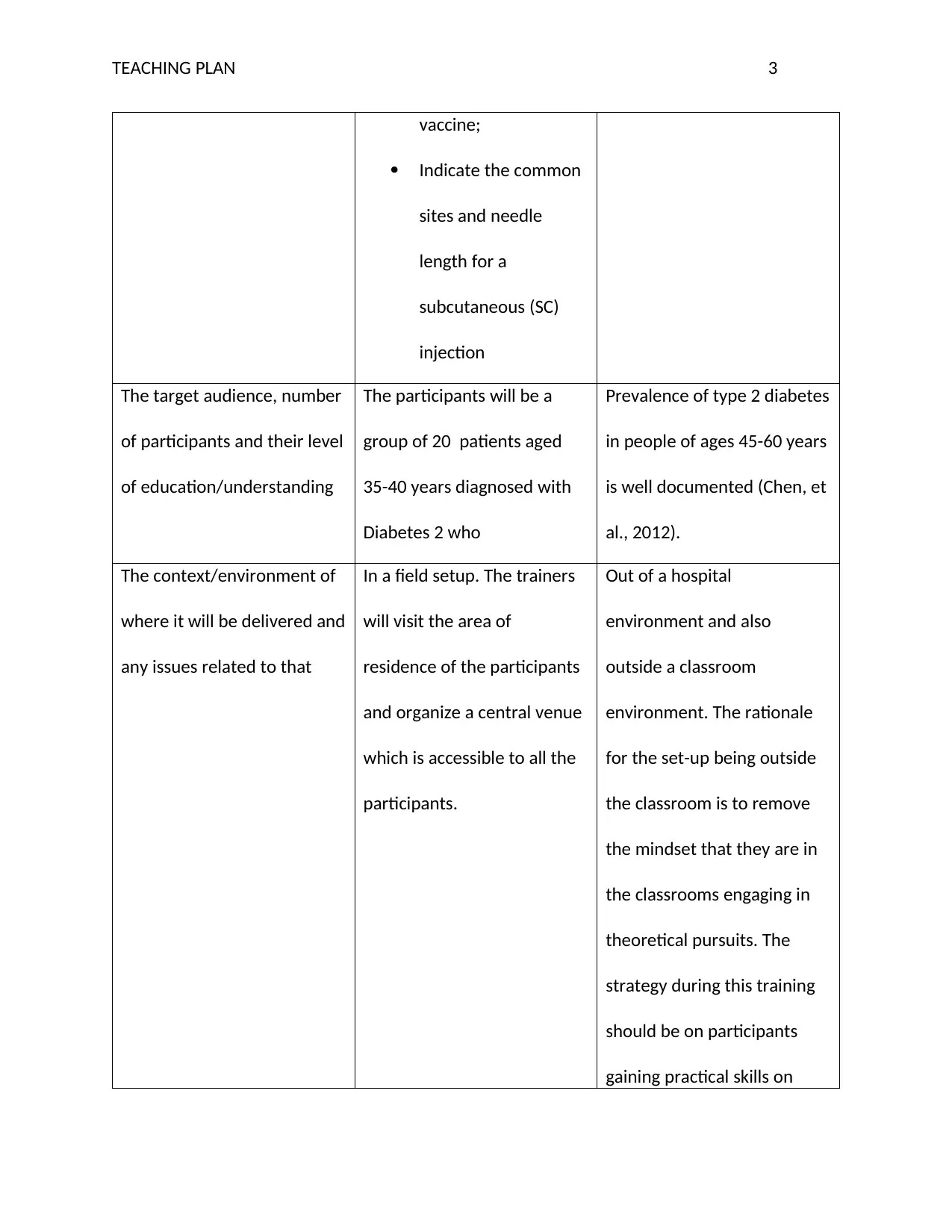
TEACHING PLAN 3
vaccine;
Indicate the common
sites and needle
length for a
subcutaneous (SC)
injection
The target audience, number
of participants and their level
of education/understanding
The participants will be a
group of 20 patients aged
35-40 years diagnosed with
Diabetes 2 who
Prevalence of type 2 diabetes
in people of ages 45-60 years
is well documented (Chen, et
al., 2012).
The context/environment of
where it will be delivered and
any issues related to that
In a field setup. The trainers
will visit the area of
residence of the participants
and organize a central venue
which is accessible to all the
participants.
Out of a hospital
environment and also
outside a classroom
environment. The rationale
for the set-up being outside
the classroom is to remove
the mindset that they are in
the classrooms engaging in
theoretical pursuits. The
strategy during this training
should be on participants
gaining practical skills on
vaccine;
Indicate the common
sites and needle
length for a
subcutaneous (SC)
injection
The target audience, number
of participants and their level
of education/understanding
The participants will be a
group of 20 patients aged
35-40 years diagnosed with
Diabetes 2 who
Prevalence of type 2 diabetes
in people of ages 45-60 years
is well documented (Chen, et
al., 2012).
The context/environment of
where it will be delivered and
any issues related to that
In a field setup. The trainers
will visit the area of
residence of the participants
and organize a central venue
which is accessible to all the
participants.
Out of a hospital
environment and also
outside a classroom
environment. The rationale
for the set-up being outside
the classroom is to remove
the mindset that they are in
the classrooms engaging in
theoretical pursuits. The
strategy during this training
should be on participants
gaining practical skills on
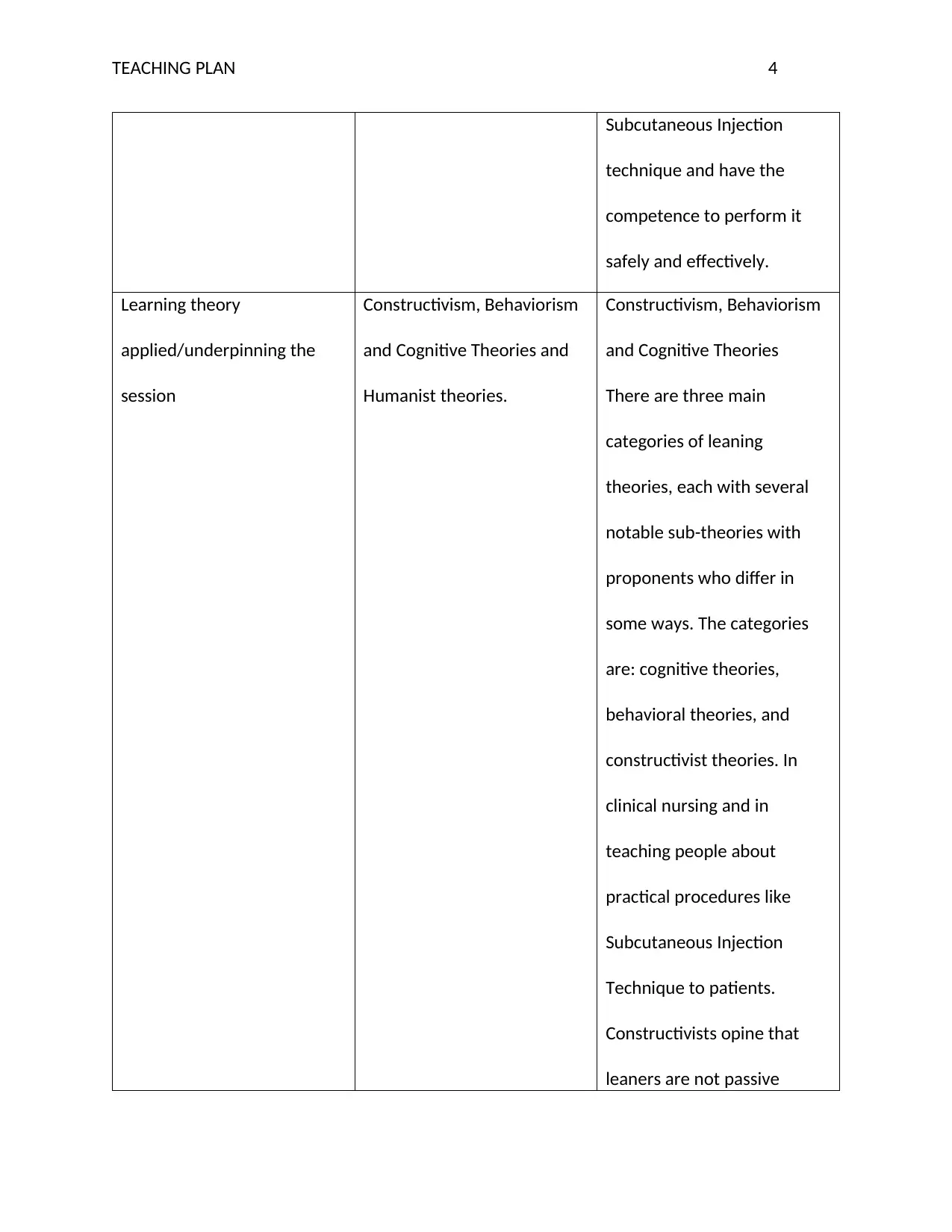
TEACHING PLAN 4
Subcutaneous Injection
technique and have the
competence to perform it
safely and effectively.
Learning theory
applied/underpinning the
session
Constructivism, Behaviorism
and Cognitive Theories and
Humanist theories.
Constructivism, Behaviorism
and Cognitive Theories
There are three main
categories of leaning
theories, each with several
notable sub-theories with
proponents who differ in
some ways. The categories
are: cognitive theories,
behavioral theories, and
constructivist theories. In
clinical nursing and in
teaching people about
practical procedures like
Subcutaneous Injection
Technique to patients.
Constructivists opine that
leaners are not passive
Subcutaneous Injection
technique and have the
competence to perform it
safely and effectively.
Learning theory
applied/underpinning the
session
Constructivism, Behaviorism
and Cognitive Theories and
Humanist theories.
Constructivism, Behaviorism
and Cognitive Theories
There are three main
categories of leaning
theories, each with several
notable sub-theories with
proponents who differ in
some ways. The categories
are: cognitive theories,
behavioral theories, and
constructivist theories. In
clinical nursing and in
teaching people about
practical procedures like
Subcutaneous Injection
Technique to patients.
Constructivists opine that
leaners are not passive
Secure Best Marks with AI Grader
Need help grading? Try our AI Grader for instant feedback on your assignments.
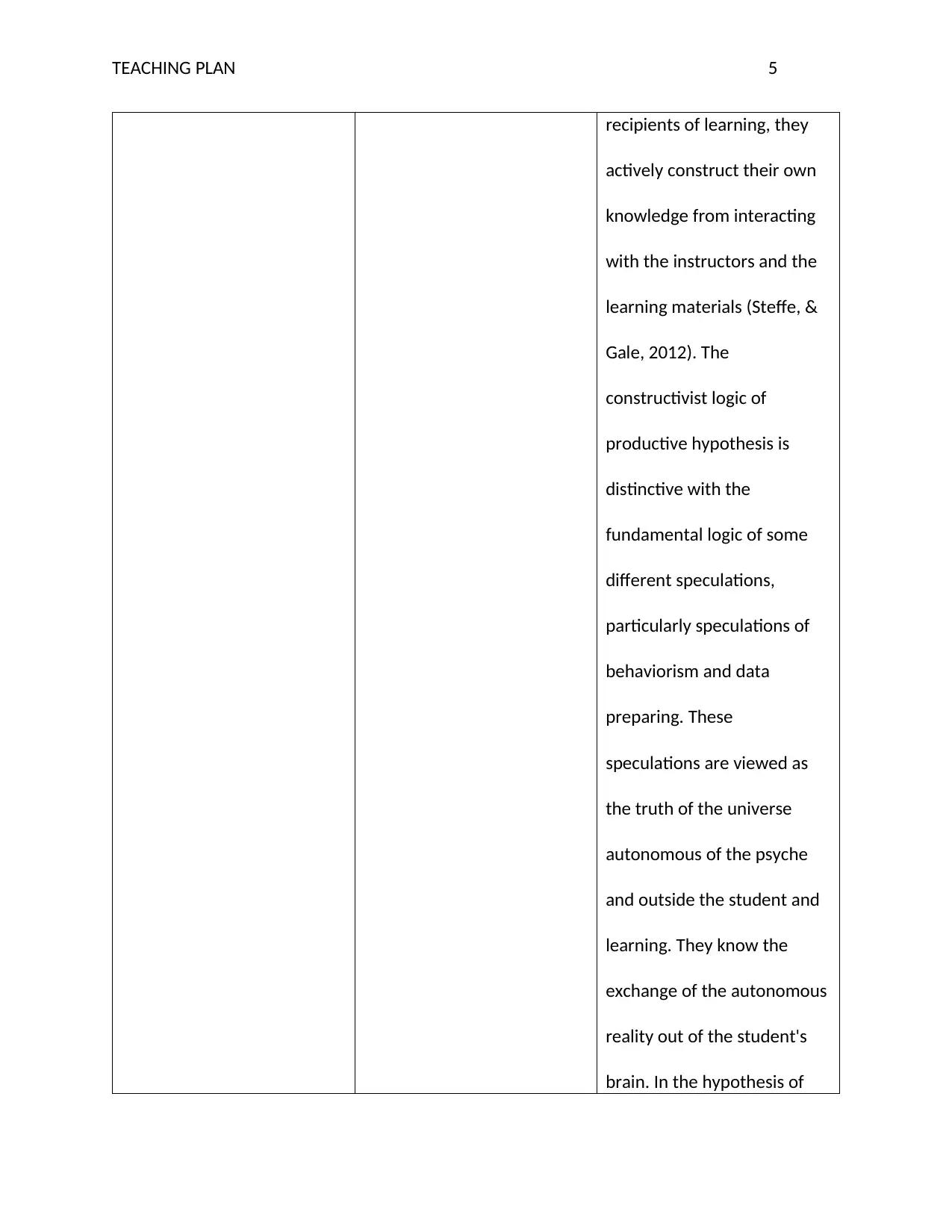
TEACHING PLAN 5
recipients of learning, they
actively construct their own
knowledge from interacting
with the instructors and the
learning materials (Steffe, &
Gale, 2012). The
constructivist logic of
productive hypothesis is
distinctive with the
fundamental logic of some
different speculations,
particularly speculations of
behaviorism and data
preparing. These
speculations are viewed as
the truth of the universe
autonomous of the psyche
and outside the student and
learning. They know the
exchange of the autonomous
reality out of the student's
brain. In the hypothesis of
recipients of learning, they
actively construct their own
knowledge from interacting
with the instructors and the
learning materials (Steffe, &
Gale, 2012). The
constructivist logic of
productive hypothesis is
distinctive with the
fundamental logic of some
different speculations,
particularly speculations of
behaviorism and data
preparing. These
speculations are viewed as
the truth of the universe
autonomous of the psyche
and outside the student and
learning. They know the
exchange of the autonomous
reality out of the student's
brain. In the hypothesis of
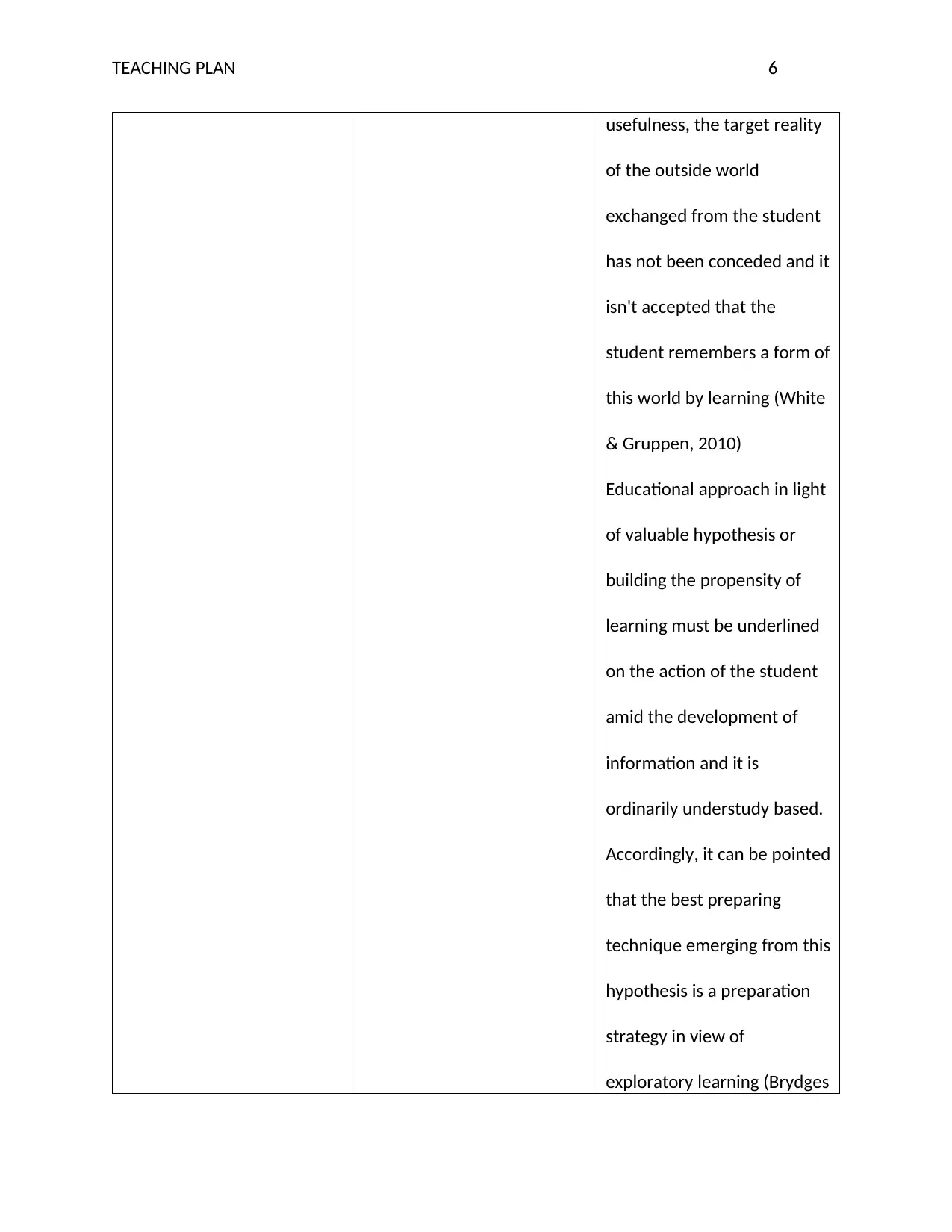
TEACHING PLAN 6
usefulness, the target reality
of the outside world
exchanged from the student
has not been conceded and it
isn't accepted that the
student remembers a form of
this world by learning (White
& Gruppen, 2010)
Educational approach in light
of valuable hypothesis or
building the propensity of
learning must be underlined
on the action of the student
amid the development of
information and it is
ordinarily understudy based.
Accordingly, it can be pointed
that the best preparing
technique emerging from this
hypothesis is a preparation
strategy in view of
exploratory learning (Brydges
usefulness, the target reality
of the outside world
exchanged from the student
has not been conceded and it
isn't accepted that the
student remembers a form of
this world by learning (White
& Gruppen, 2010)
Educational approach in light
of valuable hypothesis or
building the propensity of
learning must be underlined
on the action of the student
amid the development of
information and it is
ordinarily understudy based.
Accordingly, it can be pointed
that the best preparing
technique emerging from this
hypothesis is a preparation
strategy in view of
exploratory learning (Brydges
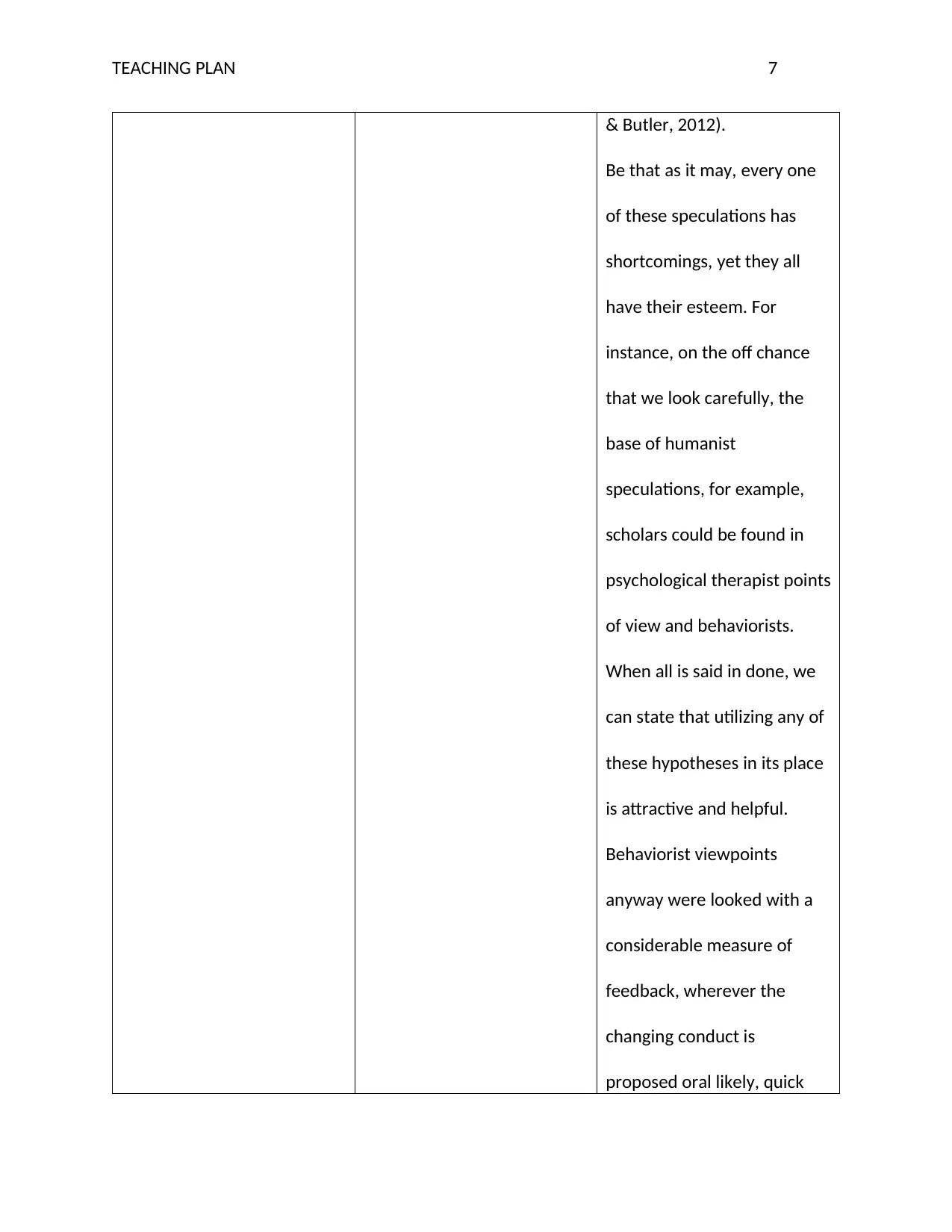
TEACHING PLAN 7
& Butler, 2012).
Be that as it may, every one
of these speculations has
shortcomings, yet they all
have their esteem. For
instance, on the off chance
that we look carefully, the
base of humanist
speculations, for example,
scholars could be found in
psychological therapist points
of view and behaviorists.
When all is said in done, we
can state that utilizing any of
these hypotheses in its place
is attractive and helpful.
Behaviorist viewpoints
anyway were looked with a
considerable measure of
feedback, wherever the
changing conduct is
proposed oral likely, quick
& Butler, 2012).
Be that as it may, every one
of these speculations has
shortcomings, yet they all
have their esteem. For
instance, on the off chance
that we look carefully, the
base of humanist
speculations, for example,
scholars could be found in
psychological therapist points
of view and behaviorists.
When all is said in done, we
can state that utilizing any of
these hypotheses in its place
is attractive and helpful.
Behaviorist viewpoints
anyway were looked with a
considerable measure of
feedback, wherever the
changing conduct is
proposed oral likely, quick
Paraphrase This Document
Need a fresh take? Get an instant paraphrase of this document with our AI Paraphraser
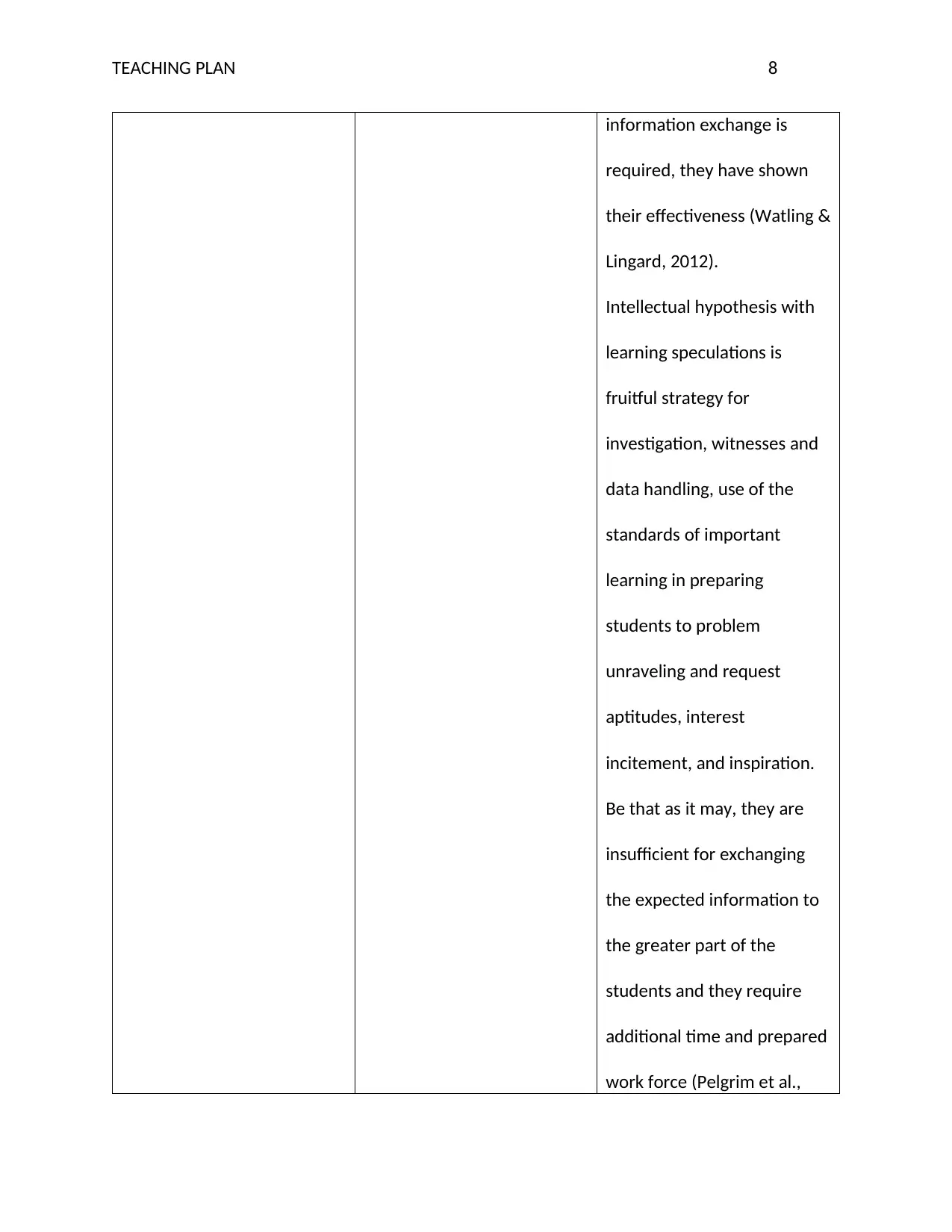
TEACHING PLAN 8
information exchange is
required, they have shown
their effectiveness (Watling &
Lingard, 2012).
Intellectual hypothesis with
learning speculations is
fruitful strategy for
investigation, witnesses and
data handling, use of the
standards of important
learning in preparing
students to problem
unraveling and request
aptitudes, interest
incitement, and inspiration.
Be that as it may, they are
insufficient for exchanging
the expected information to
the greater part of the
students and they require
additional time and prepared
work force (Pelgrim et al.,
information exchange is
required, they have shown
their effectiveness (Watling &
Lingard, 2012).
Intellectual hypothesis with
learning speculations is
fruitful strategy for
investigation, witnesses and
data handling, use of the
standards of important
learning in preparing
students to problem
unraveling and request
aptitudes, interest
incitement, and inspiration.
Be that as it may, they are
insufficient for exchanging
the expected information to
the greater part of the
students and they require
additional time and prepared
work force (Pelgrim et al.,
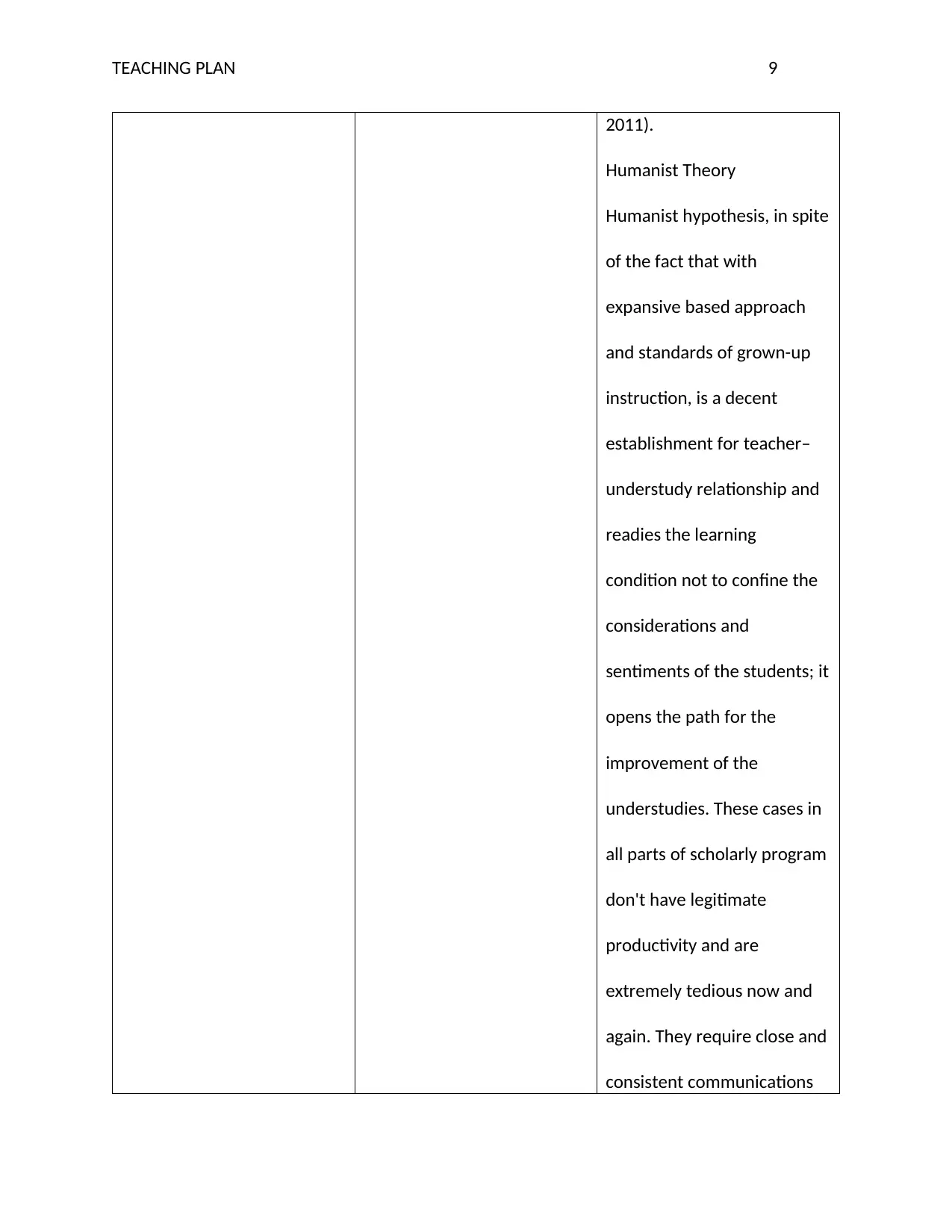
TEACHING PLAN 9
2011).
Humanist Theory
Humanist hypothesis, in spite
of the fact that with
expansive based approach
and standards of grown-up
instruction, is a decent
establishment for teacher–
understudy relationship and
readies the learning
condition not to confine the
considerations and
sentiments of the students; it
opens the path for the
improvement of the
understudies. These cases in
all parts of scholarly program
don't have legitimate
productivity and are
extremely tedious now and
again. They require close and
consistent communications
2011).
Humanist Theory
Humanist hypothesis, in spite
of the fact that with
expansive based approach
and standards of grown-up
instruction, is a decent
establishment for teacher–
understudy relationship and
readies the learning
condition not to confine the
considerations and
sentiments of the students; it
opens the path for the
improvement of the
understudies. These cases in
all parts of scholarly program
don't have legitimate
productivity and are
extremely tedious now and
again. They require close and
consistent communications
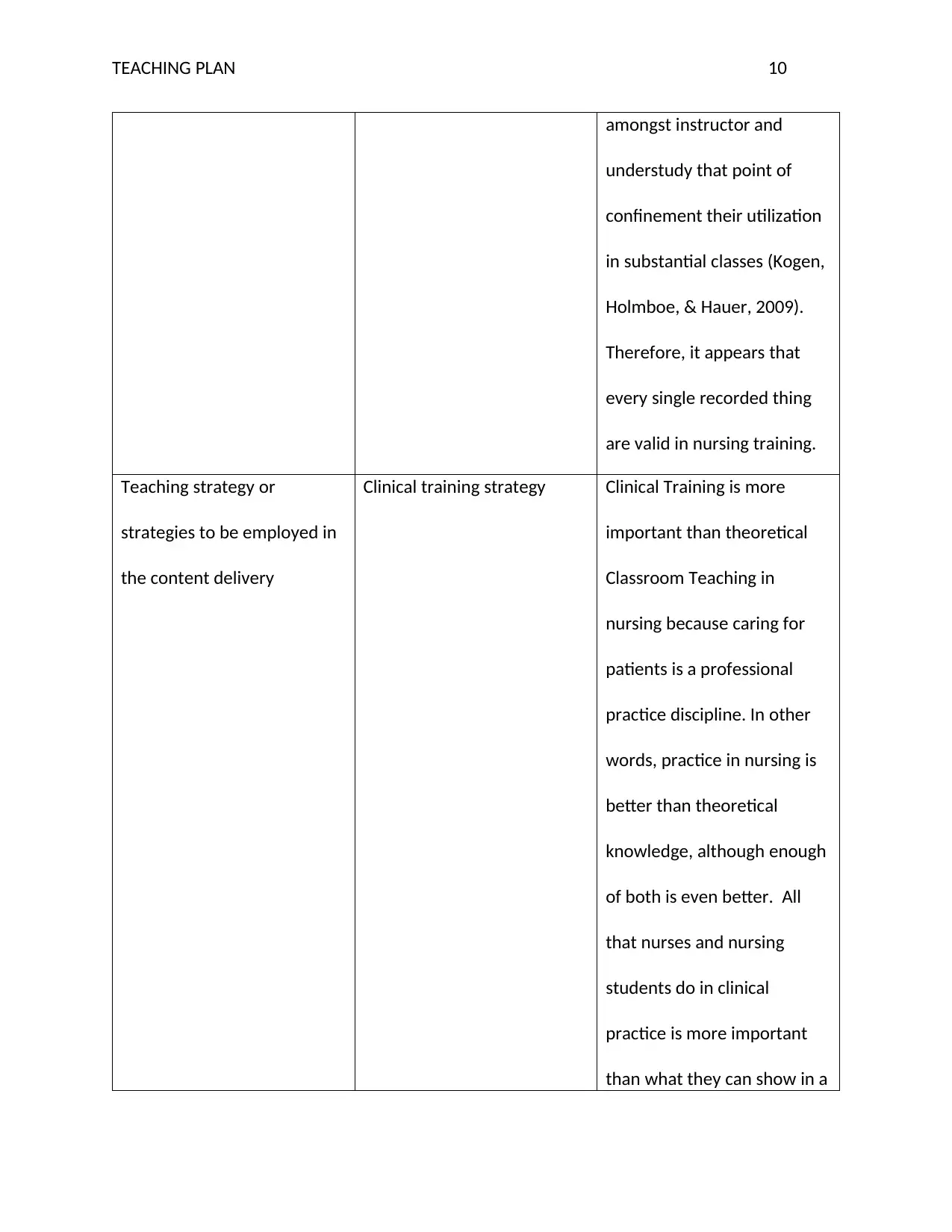
TEACHING PLAN 10
amongst instructor and
understudy that point of
confinement their utilization
in substantial classes (Kogen,
Holmboe, & Hauer, 2009).
Therefore, it appears that
every single recorded thing
are valid in nursing training.
Teaching strategy or
strategies to be employed in
the content delivery
Clinical training strategy Clinical Training is more
important than theoretical
Classroom Teaching in
nursing because caring for
patients is a professional
practice discipline. In other
words, practice in nursing is
better than theoretical
knowledge, although enough
of both is even better. All
that nurses and nursing
students do in clinical
practice is more important
than what they can show in a
amongst instructor and
understudy that point of
confinement their utilization
in substantial classes (Kogen,
Holmboe, & Hauer, 2009).
Therefore, it appears that
every single recorded thing
are valid in nursing training.
Teaching strategy or
strategies to be employed in
the content delivery
Clinical training strategy Clinical Training is more
important than theoretical
Classroom Teaching in
nursing because caring for
patients is a professional
practice discipline. In other
words, practice in nursing is
better than theoretical
knowledge, although enough
of both is even better. All
that nurses and nursing
students do in clinical
practice is more important
than what they can show in a
Secure Best Marks with AI Grader
Need help grading? Try our AI Grader for instant feedback on your assignments.
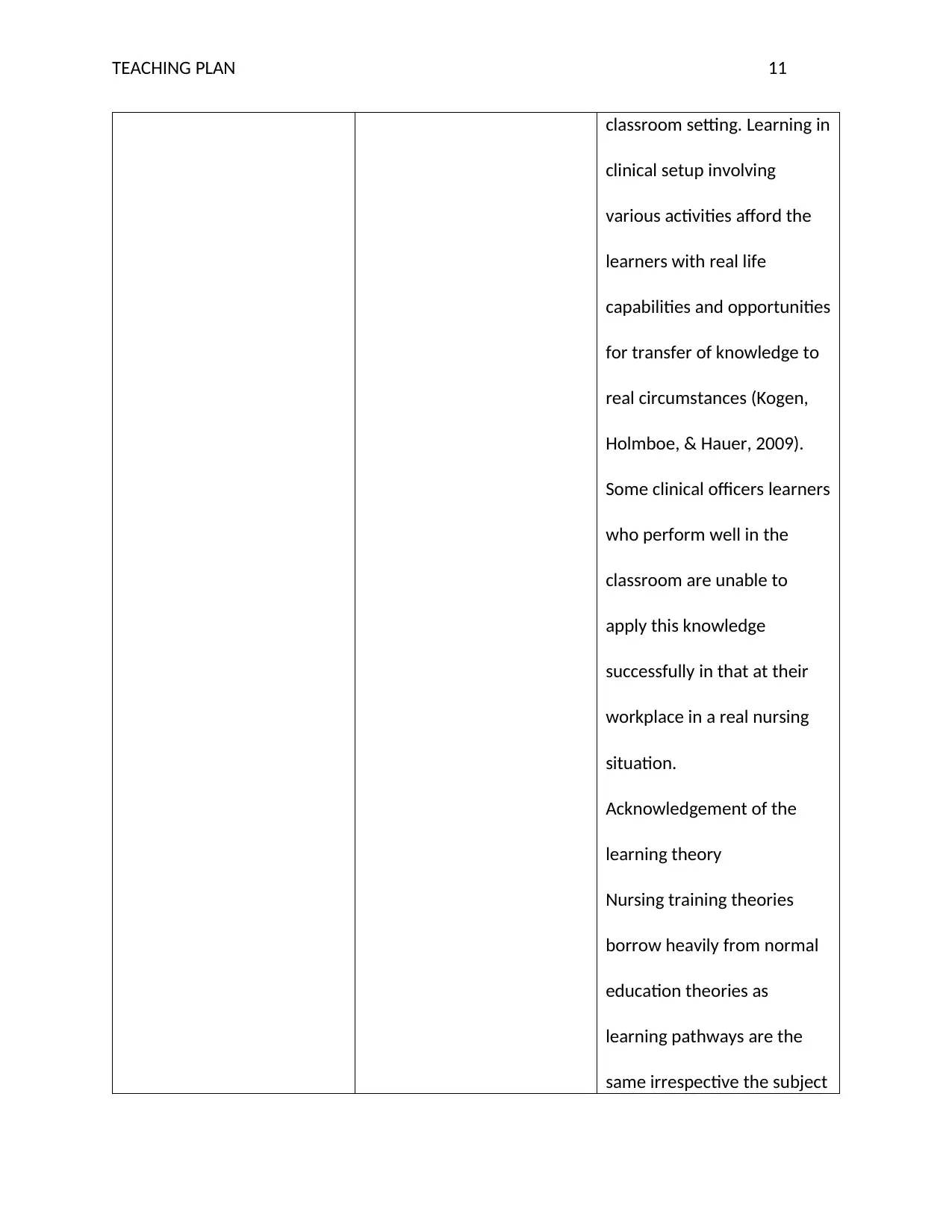
TEACHING PLAN 11
classroom setting. Learning in
clinical setup involving
various activities afford the
learners with real life
capabilities and opportunities
for transfer of knowledge to
real circumstances (Kogen,
Holmboe, & Hauer, 2009).
Some clinical officers learners
who perform well in the
classroom are unable to
apply this knowledge
successfully in that at their
workplace in a real nursing
situation.
Acknowledgement of the
learning theory
Nursing training theories
borrow heavily from normal
education theories as
learning pathways are the
same irrespective the subject
classroom setting. Learning in
clinical setup involving
various activities afford the
learners with real life
capabilities and opportunities
for transfer of knowledge to
real circumstances (Kogen,
Holmboe, & Hauer, 2009).
Some clinical officers learners
who perform well in the
classroom are unable to
apply this knowledge
successfully in that at their
workplace in a real nursing
situation.
Acknowledgement of the
learning theory
Nursing training theories
borrow heavily from normal
education theories as
learning pathways are the
same irrespective the subject
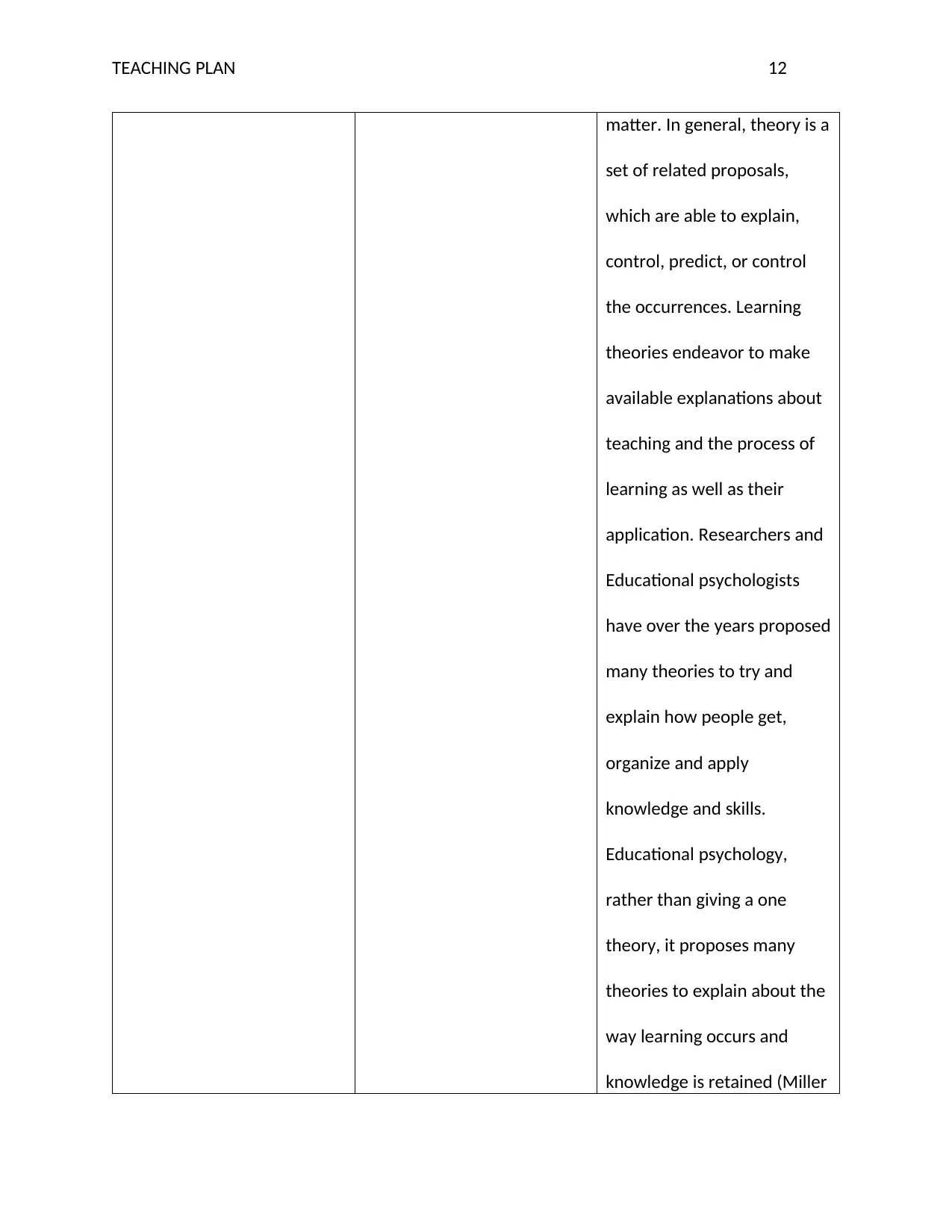
TEACHING PLAN 12
matter. In general, theory is a
set of related proposals,
which are able to explain,
control, predict, or control
the occurrences. Learning
theories endeavor to make
available explanations about
teaching and the process of
learning as well as their
application. Researchers and
Educational psychologists
have over the years proposed
many theories to try and
explain how people get,
organize and apply
knowledge and skills.
Educational psychology,
rather than giving a one
theory, it proposes many
theories to explain about the
way learning occurs and
knowledge is retained (Miller
matter. In general, theory is a
set of related proposals,
which are able to explain,
control, predict, or control
the occurrences. Learning
theories endeavor to make
available explanations about
teaching and the process of
learning as well as their
application. Researchers and
Educational psychologists
have over the years proposed
many theories to try and
explain how people get,
organize and apply
knowledge and skills.
Educational psychology,
rather than giving a one
theory, it proposes many
theories to explain about the
way learning occurs and
knowledge is retained (Miller
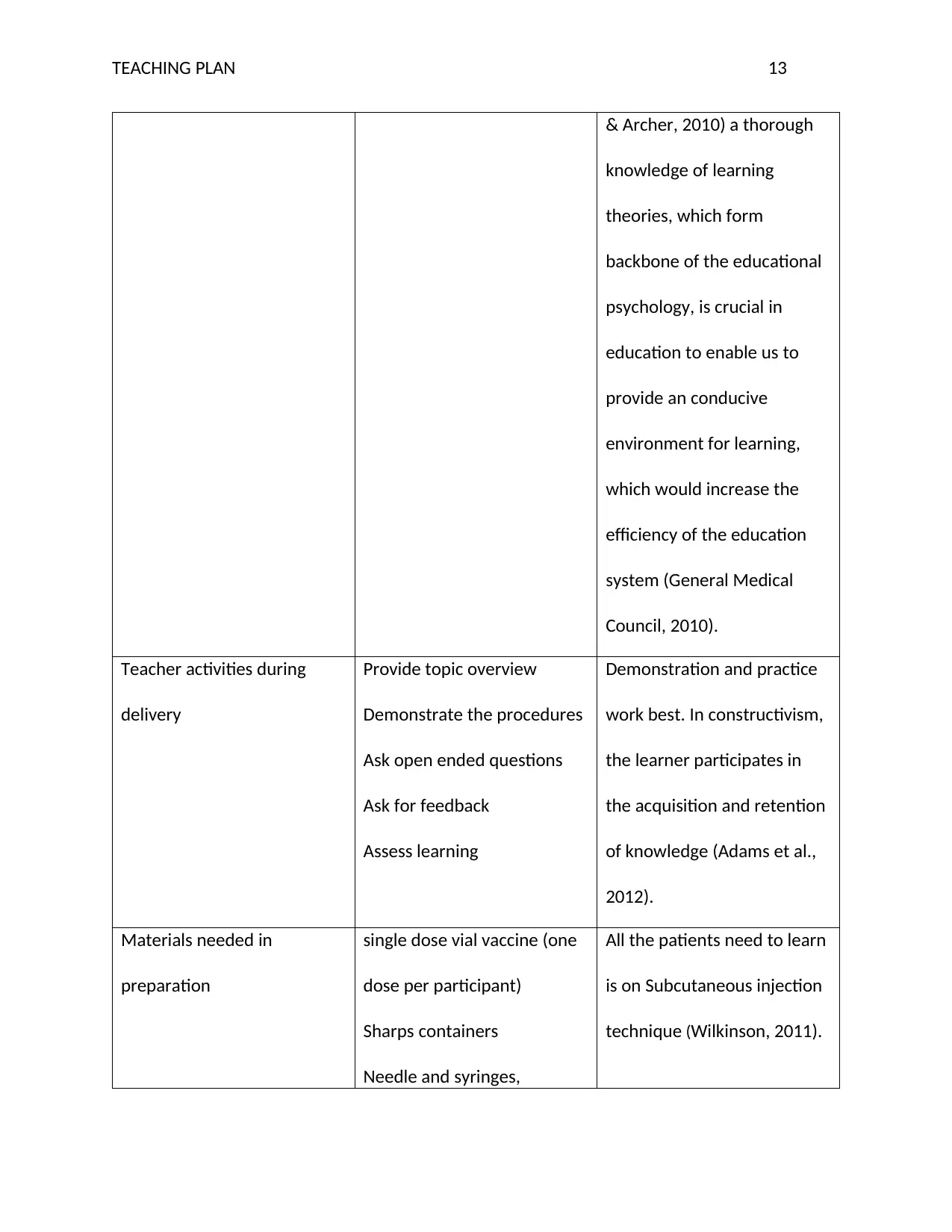
TEACHING PLAN 13
& Archer, 2010) a thorough
knowledge of learning
theories, which form
backbone of the educational
psychology, is crucial in
education to enable us to
provide an conducive
environment for learning,
which would increase the
efficiency of the education
system (General Medical
Council, 2010).
Teacher activities during
delivery
Provide topic overview
Demonstrate the procedures
Ask open ended questions
Ask for feedback
Assess learning
Demonstration and practice
work best. In constructivism,
the learner participates in
the acquisition and retention
of knowledge (Adams et al.,
2012).
Materials needed in
preparation
single dose vial vaccine (one
dose per participant)
Sharps containers
Needle and syringes,
All the patients need to learn
is on Subcutaneous injection
technique (Wilkinson, 2011).
& Archer, 2010) a thorough
knowledge of learning
theories, which form
backbone of the educational
psychology, is crucial in
education to enable us to
provide an conducive
environment for learning,
which would increase the
efficiency of the education
system (General Medical
Council, 2010).
Teacher activities during
delivery
Provide topic overview
Demonstrate the procedures
Ask open ended questions
Ask for feedback
Assess learning
Demonstration and practice
work best. In constructivism,
the learner participates in
the acquisition and retention
of knowledge (Adams et al.,
2012).
Materials needed in
preparation
single dose vial vaccine (one
dose per participant)
Sharps containers
Needle and syringes,
All the patients need to learn
is on Subcutaneous injection
technique (Wilkinson, 2011).
Paraphrase This Document
Need a fresh take? Get an instant paraphrase of this document with our AI Paraphraser
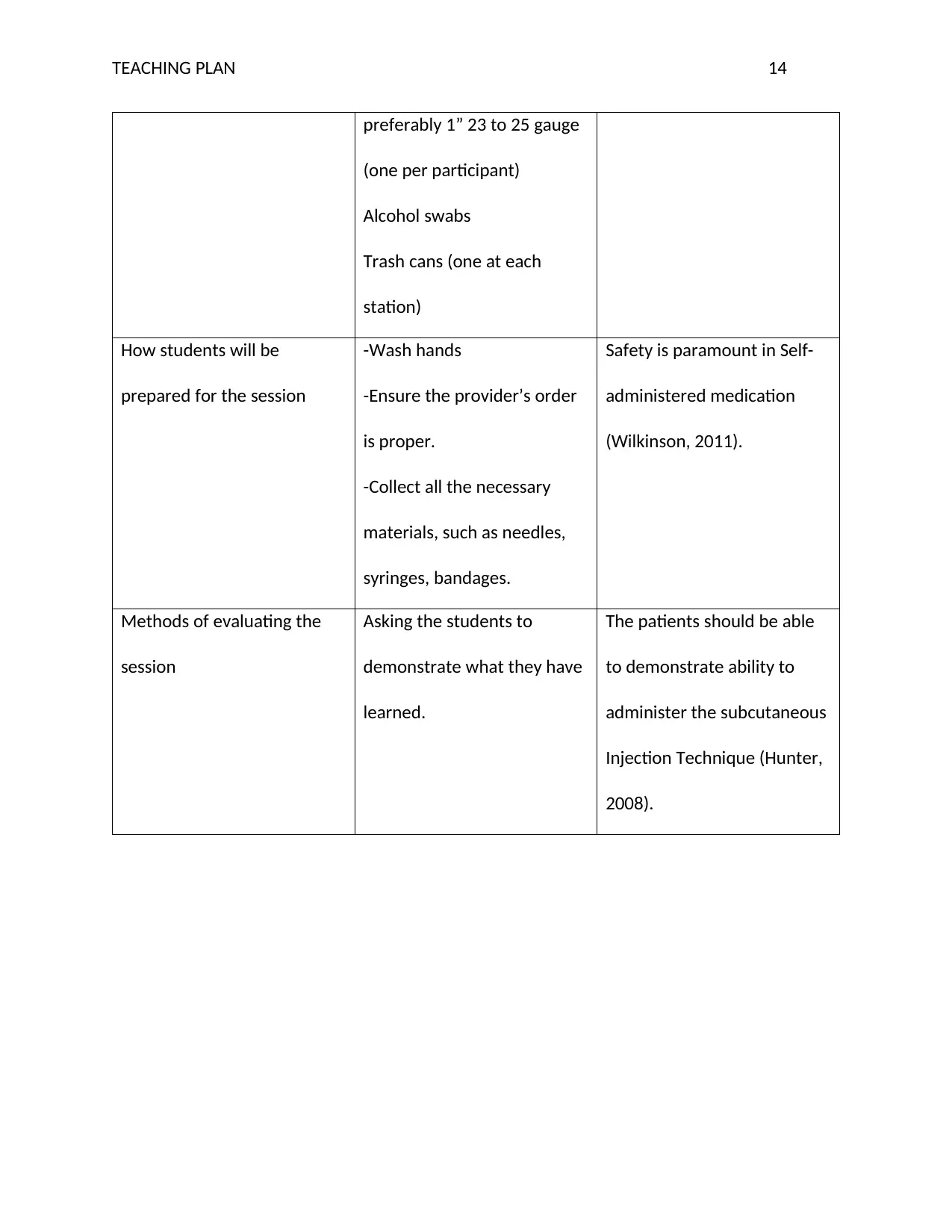
TEACHING PLAN 14
preferably 1” 23 to 25 gauge
(one per participant)
Alcohol swabs
Trash cans (one at each
station)
How students will be
prepared for the session
-Wash hands
-Ensure the provider’s order
is proper.
-Collect all the necessary
materials, such as needles,
syringes, bandages.
Safety is paramount in Self-
administered medication
(Wilkinson, 2011).
Methods of evaluating the
session
Asking the students to
demonstrate what they have
learned.
The patients should be able
to demonstrate ability to
administer the subcutaneous
Injection Technique (Hunter,
2008).
preferably 1” 23 to 25 gauge
(one per participant)
Alcohol swabs
Trash cans (one at each
station)
How students will be
prepared for the session
-Wash hands
-Ensure the provider’s order
is proper.
-Collect all the necessary
materials, such as needles,
syringes, bandages.
Safety is paramount in Self-
administered medication
(Wilkinson, 2011).
Methods of evaluating the
session
Asking the students to
demonstrate what they have
learned.
The patients should be able
to demonstrate ability to
administer the subcutaneous
Injection Technique (Hunter,
2008).
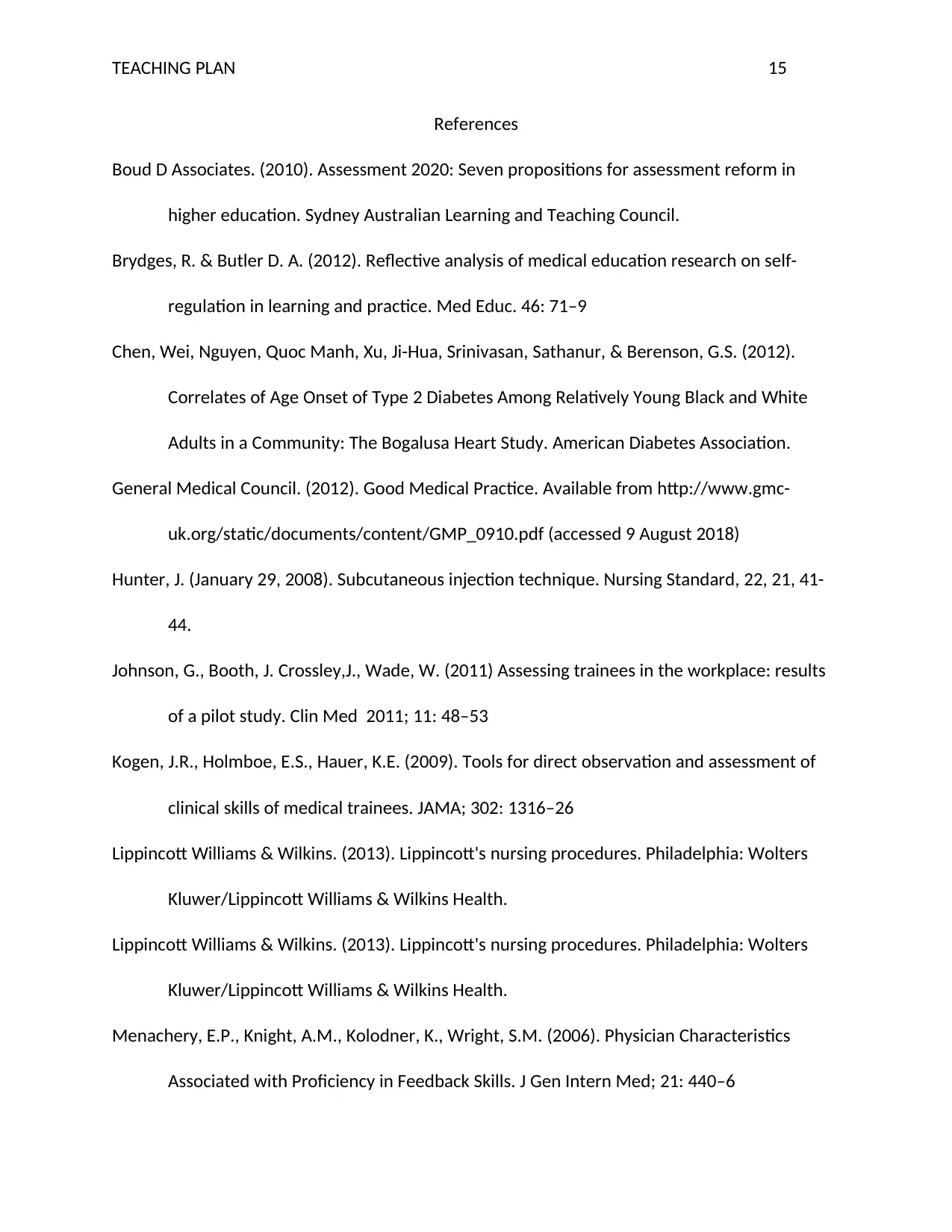
TEACHING PLAN 15
References
Boud D Associates. (2010). Assessment 2020: Seven propositions for assessment reform in
higher education. Sydney Australian Learning and Teaching Council.
Brydges, R. & Butler D. A. (2012). Reflective analysis of medical education research on self-
regulation in learning and practice. Med Educ. 46: 71–9
Chen, Wei, Nguyen, Quoc Manh, Xu, Ji-Hua, Srinivasan, Sathanur, & Berenson, G.S. (2012).
Correlates of Age Onset of Type 2 Diabetes Among Relatively Young Black and White
Adults in a Community: The Bogalusa Heart Study. American Diabetes Association.
General Medical Council. (2012). Good Medical Practice. Available from http://www.gmc-
uk.org/static/documents/content/GMP_0910.pdf (accessed 9 August 2018)
Hunter, J. (January 29, 2008). Subcutaneous injection technique. Nursing Standard, 22, 21, 41-
44.
Johnson, G., Booth, J. Crossley,J., Wade, W. (2011) Assessing trainees in the workplace: results
of a pilot study. Clin Med 2011; 11: 48–53
Kogen, J.R., Holmboe, E.S., Hauer, K.E. (2009). Tools for direct observation and assessment of
clinical skills of medical trainees. JAMA; 302: 1316–26
Lippincott Williams & Wilkins. (2013). Lippincott's nursing procedures. Philadelphia: Wolters
Kluwer/Lippincott Williams & Wilkins Health.
Lippincott Williams & Wilkins. (2013). Lippincott's nursing procedures. Philadelphia: Wolters
Kluwer/Lippincott Williams & Wilkins Health.
Menachery, E.P., Knight, A.M., Kolodner, K., Wright, S.M. (2006). Physician Characteristics
Associated with Proficiency in Feedback Skills. J Gen Intern Med; 21: 440–6
References
Boud D Associates. (2010). Assessment 2020: Seven propositions for assessment reform in
higher education. Sydney Australian Learning and Teaching Council.
Brydges, R. & Butler D. A. (2012). Reflective analysis of medical education research on self-
regulation in learning and practice. Med Educ. 46: 71–9
Chen, Wei, Nguyen, Quoc Manh, Xu, Ji-Hua, Srinivasan, Sathanur, & Berenson, G.S. (2012).
Correlates of Age Onset of Type 2 Diabetes Among Relatively Young Black and White
Adults in a Community: The Bogalusa Heart Study. American Diabetes Association.
General Medical Council. (2012). Good Medical Practice. Available from http://www.gmc-
uk.org/static/documents/content/GMP_0910.pdf (accessed 9 August 2018)
Hunter, J. (January 29, 2008). Subcutaneous injection technique. Nursing Standard, 22, 21, 41-
44.
Johnson, G., Booth, J. Crossley,J., Wade, W. (2011) Assessing trainees in the workplace: results
of a pilot study. Clin Med 2011; 11: 48–53
Kogen, J.R., Holmboe, E.S., Hauer, K.E. (2009). Tools for direct observation and assessment of
clinical skills of medical trainees. JAMA; 302: 1316–26
Lippincott Williams & Wilkins. (2013). Lippincott's nursing procedures. Philadelphia: Wolters
Kluwer/Lippincott Williams & Wilkins Health.
Lippincott Williams & Wilkins. (2013). Lippincott's nursing procedures. Philadelphia: Wolters
Kluwer/Lippincott Williams & Wilkins Health.
Menachery, E.P., Knight, A.M., Kolodner, K., Wright, S.M. (2006). Physician Characteristics
Associated with Proficiency in Feedback Skills. J Gen Intern Med; 21: 440–6
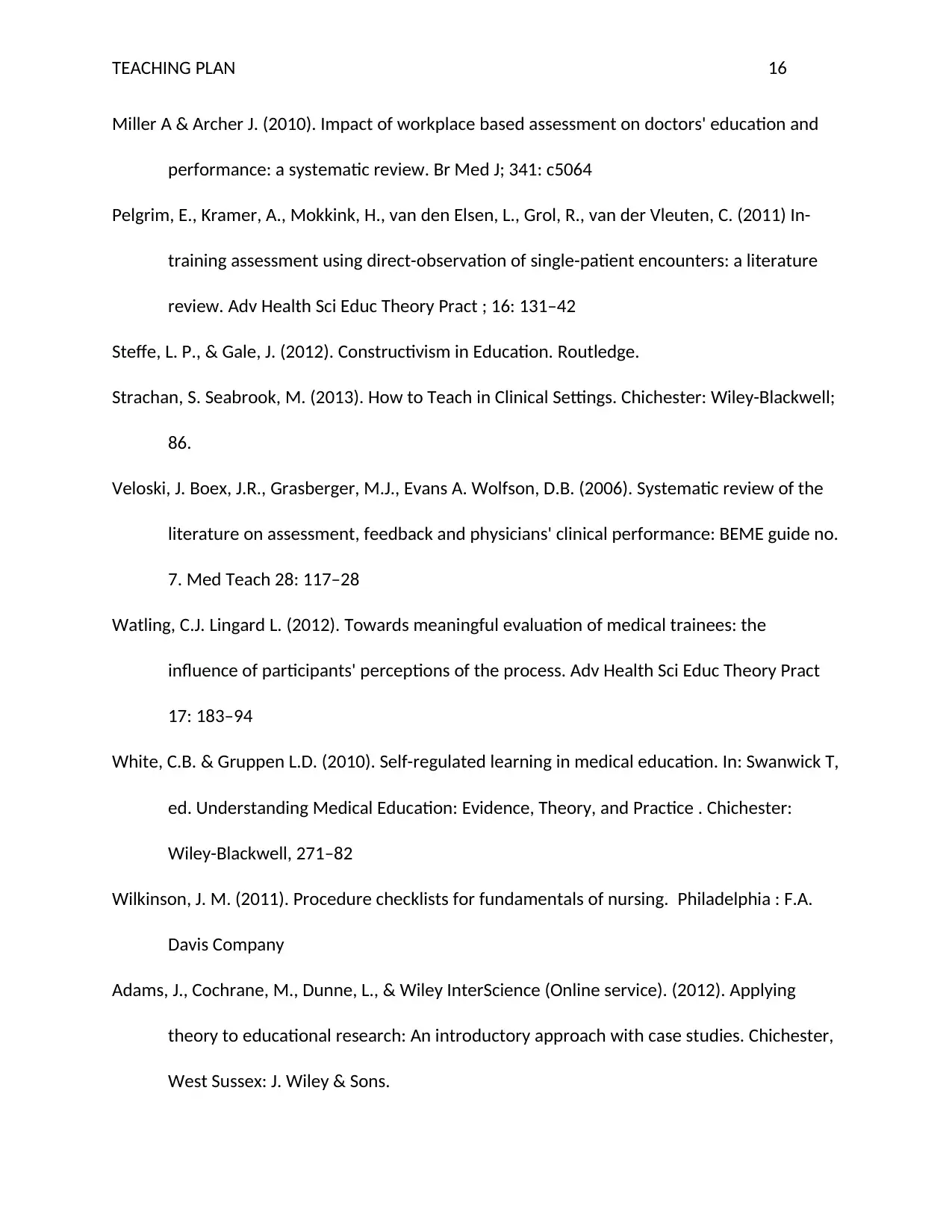
TEACHING PLAN 16
Miller A & Archer J. (2010). Impact of workplace based assessment on doctors' education and
performance: a systematic review. Br Med J; 341: c5064
Pelgrim, E., Kramer, A., Mokkink, H., van den Elsen, L., Grol, R., van der Vleuten, C. (2011) In-
training assessment using direct-observation of single-patient encounters: a literature
review. Adv Health Sci Educ Theory Pract ; 16: 131–42
Steffe, L. P., & Gale, J. (2012). Constructivism in Education. Routledge.
Strachan, S. Seabrook, M. (2013). How to Teach in Clinical Settings. Chichester: Wiley-Blackwell;
86.
Veloski, J. Boex, J.R., Grasberger, M.J., Evans A. Wolfson, D.B. (2006). Systematic review of the
literature on assessment, feedback and physicians' clinical performance: BEME guide no.
7. Med Teach 28: 117–28
Watling, C.J. Lingard L. (2012). Towards meaningful evaluation of medical trainees: the
influence of participants' perceptions of the process. Adv Health Sci Educ Theory Pract
17: 183–94
White, C.B. & Gruppen L.D. (2010). Self-regulated learning in medical education. In: Swanwick T,
ed. Understanding Medical Education: Evidence, Theory, and Practice . Chichester:
Wiley-Blackwell, 271–82
Wilkinson, J. M. (2011). Procedure checklists for fundamentals of nursing. Philadelphia : F.A.
Davis Company
Adams, J., Cochrane, M., Dunne, L., & Wiley InterScience (Online service). (2012). Applying
theory to educational research: An introductory approach with case studies. Chichester,
West Sussex: J. Wiley & Sons.
Miller A & Archer J. (2010). Impact of workplace based assessment on doctors' education and
performance: a systematic review. Br Med J; 341: c5064
Pelgrim, E., Kramer, A., Mokkink, H., van den Elsen, L., Grol, R., van der Vleuten, C. (2011) In-
training assessment using direct-observation of single-patient encounters: a literature
review. Adv Health Sci Educ Theory Pract ; 16: 131–42
Steffe, L. P., & Gale, J. (2012). Constructivism in Education. Routledge.
Strachan, S. Seabrook, M. (2013). How to Teach in Clinical Settings. Chichester: Wiley-Blackwell;
86.
Veloski, J. Boex, J.R., Grasberger, M.J., Evans A. Wolfson, D.B. (2006). Systematic review of the
literature on assessment, feedback and physicians' clinical performance: BEME guide no.
7. Med Teach 28: 117–28
Watling, C.J. Lingard L. (2012). Towards meaningful evaluation of medical trainees: the
influence of participants' perceptions of the process. Adv Health Sci Educ Theory Pract
17: 183–94
White, C.B. & Gruppen L.D. (2010). Self-regulated learning in medical education. In: Swanwick T,
ed. Understanding Medical Education: Evidence, Theory, and Practice . Chichester:
Wiley-Blackwell, 271–82
Wilkinson, J. M. (2011). Procedure checklists for fundamentals of nursing. Philadelphia : F.A.
Davis Company
Adams, J., Cochrane, M., Dunne, L., & Wiley InterScience (Online service). (2012). Applying
theory to educational research: An introductory approach with case studies. Chichester,
West Sussex: J. Wiley & Sons.
Secure Best Marks with AI Grader
Need help grading? Try our AI Grader for instant feedback on your assignments.
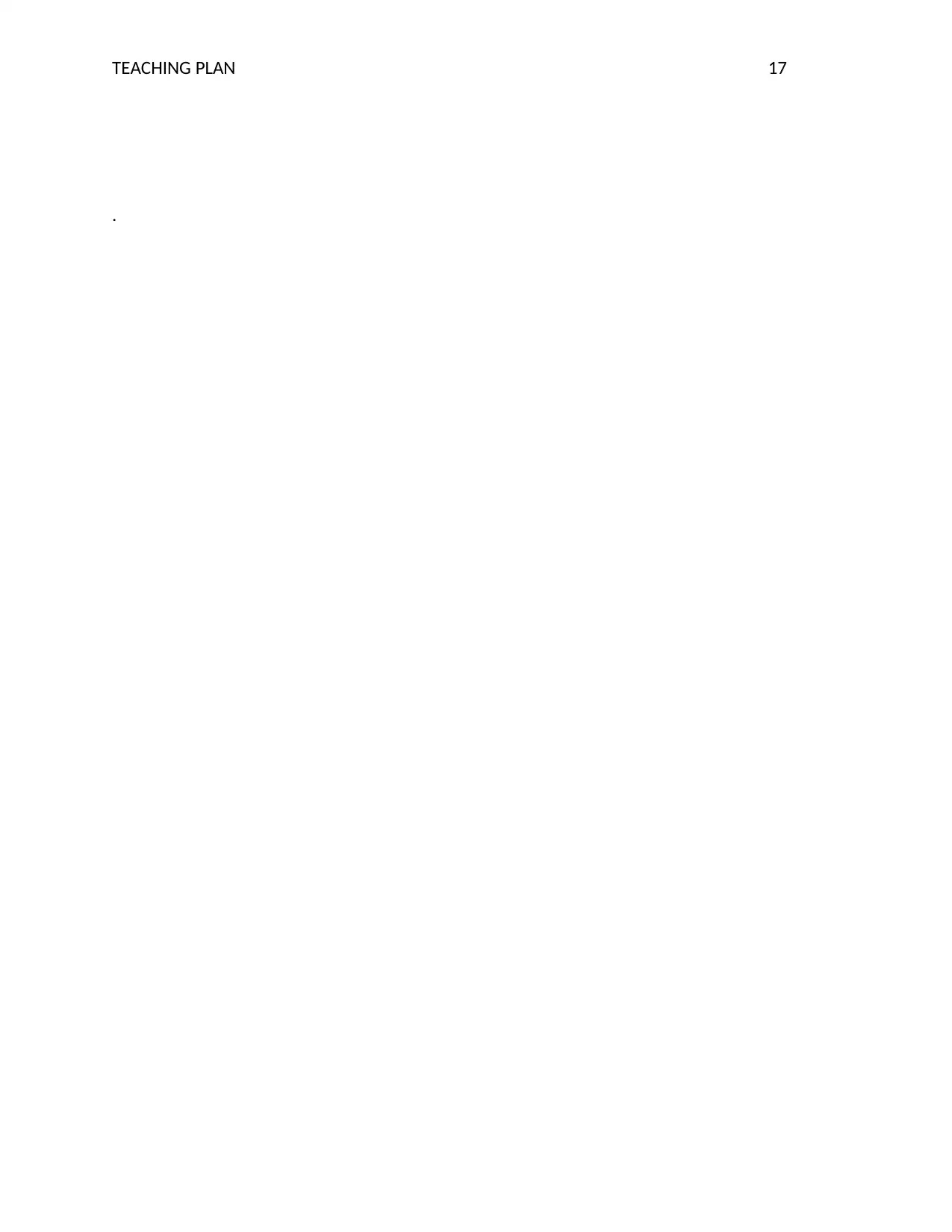
TEACHING PLAN 17
.
.
1 out of 17
Your All-in-One AI-Powered Toolkit for Academic Success.
+13062052269
info@desklib.com
Available 24*7 on WhatsApp / Email
![[object Object]](/_next/static/media/star-bottom.7253800d.svg)
Unlock your academic potential
© 2024 | Zucol Services PVT LTD | All rights reserved.